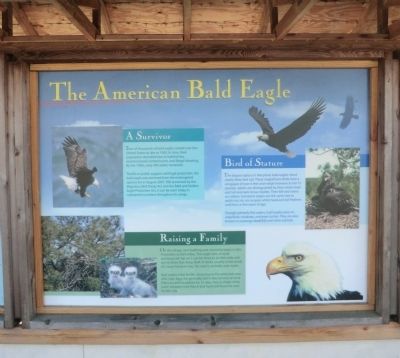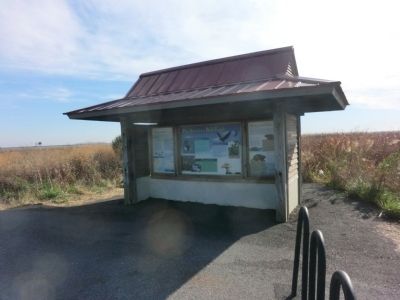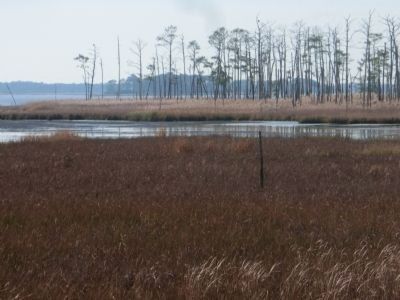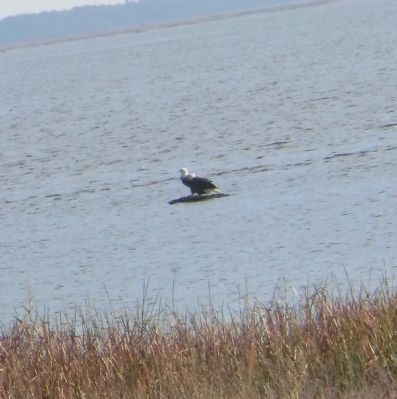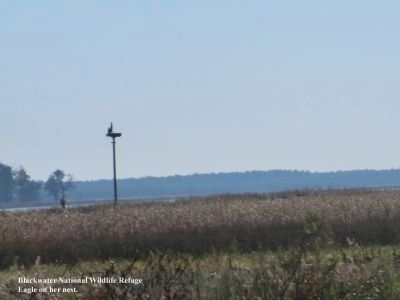Near Church Creek in Dorchester County, Maryland — The American Northeast (Mid-Atlantic)
The American Bald Eagle
Blackwater National Wildlife Refuge
A Survivor
Tens of thousands of bald eagles soared over the United States as late as 1800. In time, their population dwindled due to habitat loss, environmental contaminants, and illegal shooting. By the 1960s, only 400 adults remained.
Thanks to public support and legal protection, the bald eagle was removed from the endangered species list in August 2007. Still protected by the Migratory Bird Treaty Act and the Bald and Golden Eagle Protection Act, it can be seen today in substantial numbers throughout its range.
Raising a Family
On the refuge, nest building and courtship begin in late November or December. The eagle nest or eyrie (pronounced “ear-ee”), can be three to six feet wide and two to three feet deep. Built of sticks, usually in the crook of a large live pine tree, the nest is normally near water. Bald eagles mate for life, returning to the same nest year after year. Eggs are generally laid in late January or early February and incubated for 35 days. One to three chicks hatch between mid-March and April and leave the nest by late July.
Bird of Stature
The largest raptors in Maryland, bald eagles stand nearly three feet tall. These magnificent birds have a wingspan of over 6 feet and weigh between 8 and 15 pounds. Adults are distinguished by their white head and tail and dark brown bodies. Their bill and talons are yellow. Immature eagles are the same size as adults but do not acquire white head and tail feathers until four or five years of age.
Through primarily fish eaters, bald eagles prey on waterfowl, muskrats, and even turtles. They are also known to scavenge dead fish and other animals.
Topics. This historical marker is listed in these topic lists: Animals • Environment. A significant historical year for this entry is 1800.
Location. 38° 26.25′ N, 76° 5.55′ W. Marker is near Church Creek, Maryland, in Dorchester County. Marker is on Observation Acess Road. Touch for map. Marker is in this post office area: Cambridge MD 21613, United States of America. Touch for directions.
Other nearby markers. At least 8 other markers are within 2 miles of this marker, measured as the crow flies. The Chesapeake Bay Ecosystem (here, next to this marker); Muskrat and Nutria (here, next to this marker); Pool One at Wildlife Drive (approx. 0.4 miles away); Delmarva Peninsula Fox Squirrel (approx. 0.9 miles away); Why Use Native Plants? (approx. 1.6 miles away); Welcome to Blackwater National Wildlife Refuge (approx. 1.6 miles away); a different marker also named Welcome to Blackwater National Wildlife Refuge (approx. 1.6 miles away); Blackwater National Wildlife Refuge (approx. 1.6 miles away). Touch for a list and map of all markers in Church Creek.
Credits. This page was last revised on August 28, 2022. It was originally submitted on November 14, 2014, by Don Morfe of Baltimore, Maryland. This page has been viewed 304 times since then and 10 times this year. Photos: 1, 2, 3, 4, 5. submitted on November 14, 2014, by Don Morfe of Baltimore, Maryland. • Bill Pfingsten was the editor who published this page.
